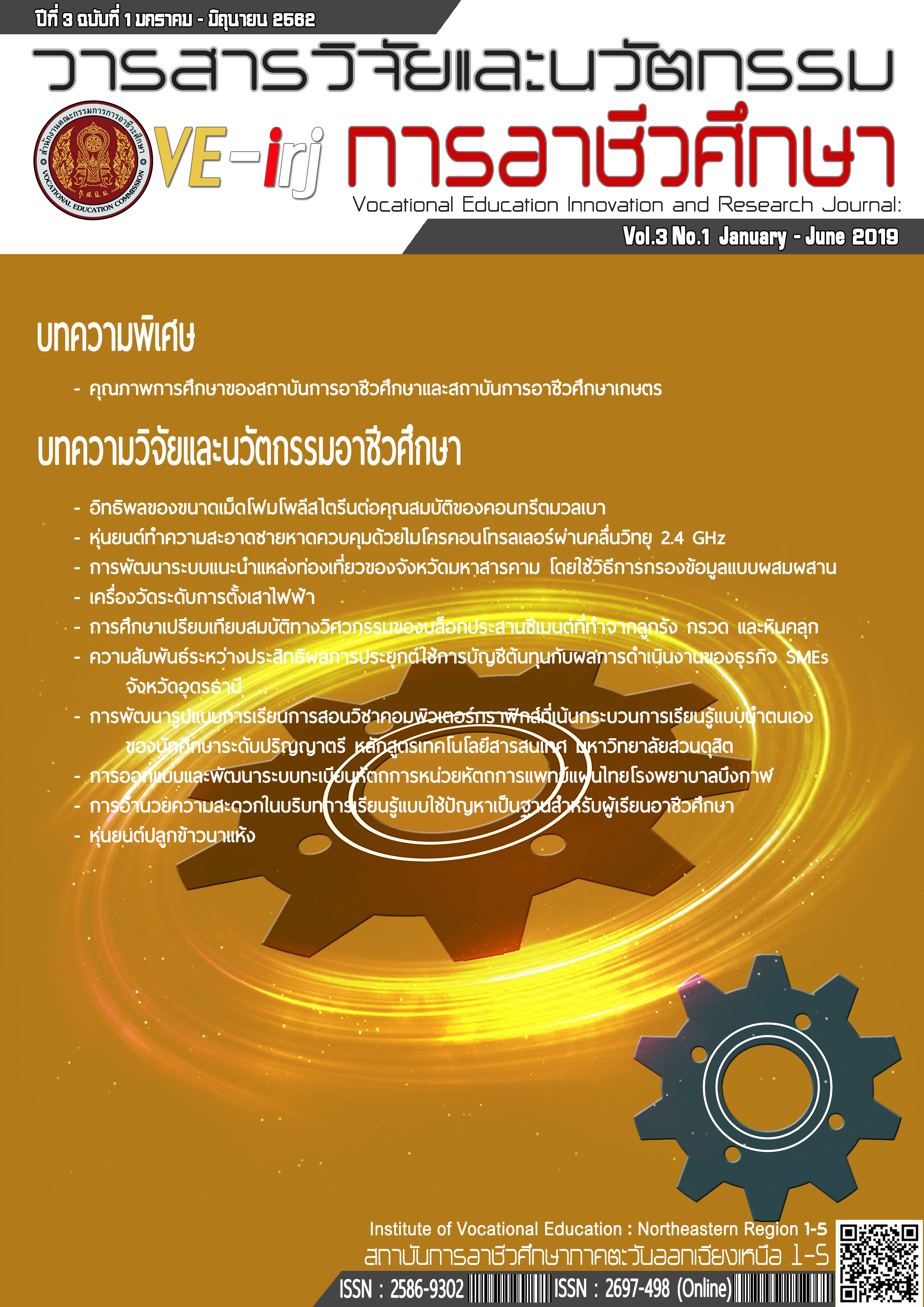อิทธิพลของขนาดเม็ดโฟมโพลิสไตรีนต่อคุณสมบัติของคอนกรีตมวลเบา
Main Article Content
บทคัดย่อ
งานวิจัยนี้มุ่งศึกษาอิทธิพลของปริมาณและขนาดเม็ดโฟมโพลิสไตรีนต่อสมบัติด้านความหนาแน่น กำลังรับแรงอัด และการดูดซึมน้ำของคอนกรีตมวลเบา โดยศึกษาอัตราส่วนผสมคอนกรีต 3 อัตราส่วน คือ ปูนซีเมนต์-ทราย-เม็ดโฟม (C-S-F) เท่ากับ 1-1-1, 1-1-1.5 และ 1-1-2.0 สำหรับแต่ละอัตราส่วนผสม จะใช้เม็ดโฟมโพลิสไตรีน 3 ขนาด คือ ขนาดเส้นผ่านศูนย์กลางเฉลี่ย 2.0 มิลลิเมตร 4.75 มิลลิเมตร และ 9.50 มิลลิเมตร โดยกำหนดอัตราส่วนน้ำต่อปูนซีเมนต์คงที่เท่ากับ 0.40 ผลการศึกษาพบว่า การผสมเม็ดโฟมขนาดเล็กจะทำให้กำลังรับแรงอัดของคอนกรีตมีค่าต่ำเมื่อเปรียบเทียบกับการใช้เม็ดโฟมขนาดใหญ่ การใช้เม็ดโฟมขนาดต่างกันส่งผลต่อค่าความหนาแน่นของคอนกรีตเพียงเล็กน้อย กำลังรับแรงอัดและความหนาแน่นของคอนกรีตจะลดต่ำลงตามการเพิ่มขึ้นของปริมาณเม็ดโฟมที่ใช้ คอนกรีตที่ผสมเม็ดโฟมจะมีค่าการดูดซึมน้ำสูงขึ้นเมื่อเปรียบเทียบกับคอนกรีตควบคุม
Article Details
สงวนสิทธิ์ โดย สถาบันการอาชีวศึกษาภาคตะวันออกเฉียงเหนือ 1
306 หมู่ 5 ถนนมิตรภาพ หนองคาย-อุดรธานี ตำบลโพธิ์ชัย อำเภอเมืองหนองคาย จังหวัดหนองคาย 43000
โทร 0-4241-1445,0-4241-1447
ISSN : 2586-9302 (print) ISSN : 2697-4983 (online)
References
[2] N. Narayanan and K. Ramamurthy. “Structure and properties of aerated concrete: a review”. Cement Concrete and Composites, 22, pp. 321-329, 2000.
[3] Tiong-hua Wee, Daneti Saradhi Babu, T. Tamilselvan, and Hwee-sin Lim. “Air-void system of foamed concrete and its effect on mechanical properties”. ACI Mater J, 106, pp. 45-52, 2006.
[4] M.R. Jones and A. McCarthy. “Preliminary views on the potential of foamed concrete as a structure material”. Mag Concr Res, 57, pp. 21-31, 2005.
[5] D.S. Babu, K.G. Babu, and T.H. Wee. “Effect of polystyrene aggregate size on the strength and moisture migration characteristics of lightweight concrete”. Cem Concr Compos, 28, pp. 520-527, 2006.
[6] K. Ganesh Babu and D. Saradhi Babu. “Behaviour of lightweight expanded polystyrene concrete containing silica fume”. Cem Concr Res, 33, pp. 755-762, 2003.
[7] D. Saradhi Babu, K. Ganesh Babu, and T.H. Wee. “Properties of lightweight expanded polystyrene aggregate concretes containing fly ash”. Cem Concr Res, 35, pp. 1218-1223, 2005.
[8] R. Sri Ravindrarajah and A.J. Tuck. “Properties of hardened concrete containing treated expanded polystyrene beads”. Cem Concr Compos, 16, pp. 273-277, 1994.
[9] Ning Liu and Bing Chen. “Experimental study of the influence of EPS particle size on the mechanical properties of EPS lightweight concrete”. Con Build Mat, 68, pp. 227-232, 2014.
[10] Thai Industrial Standard Institute, “TIS 15: 2555 Thai standard for Portland cement: Part I specification”, TISI: Bangkok, 2012.
[11] British Standard Institute, “BS EN 12390-3: Testing hardened concrete. Compressive strength of test specimens", BSI: UK, 2009.
[12] British Standard Institute, “BS 1881-122: Testing concrete. Method for determination of water absorption”, BSI: UK, 2011.
[13] Thai Industrial Standard Institute, “TIS 38: 2533 Standard for hollow non-load bearing concrete masonry units”, TISI: Bangkok, 1990.

